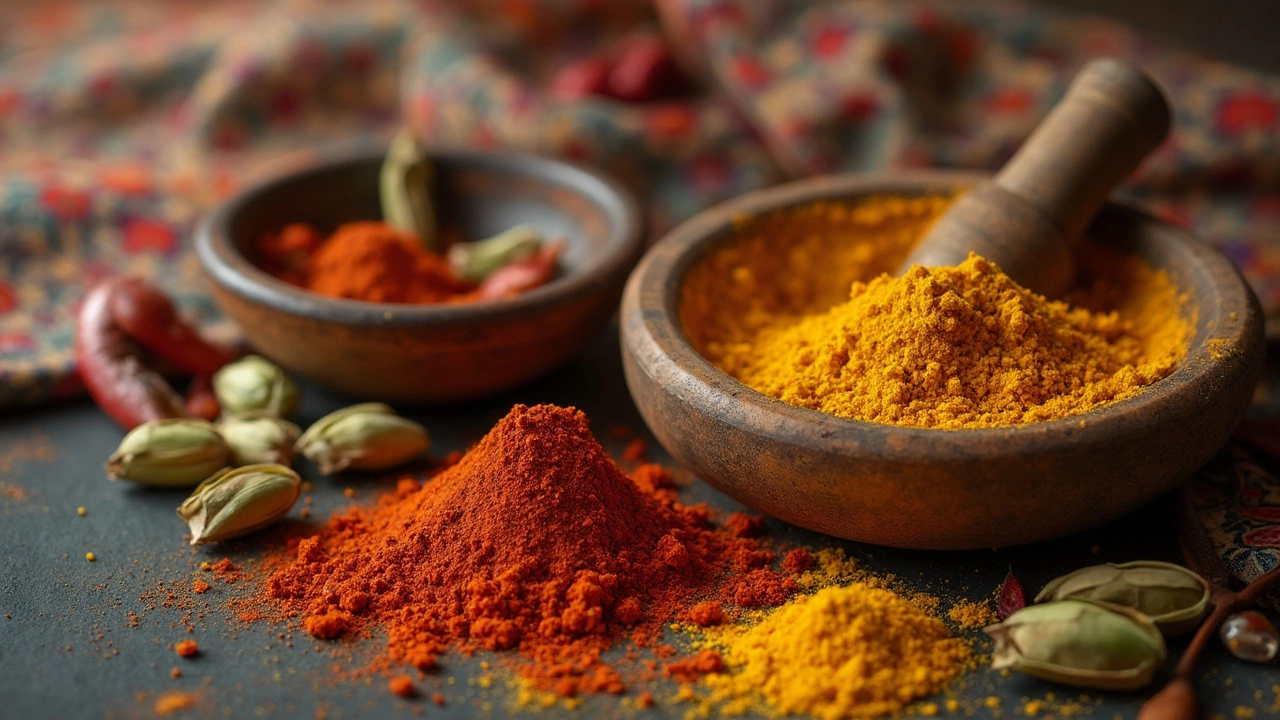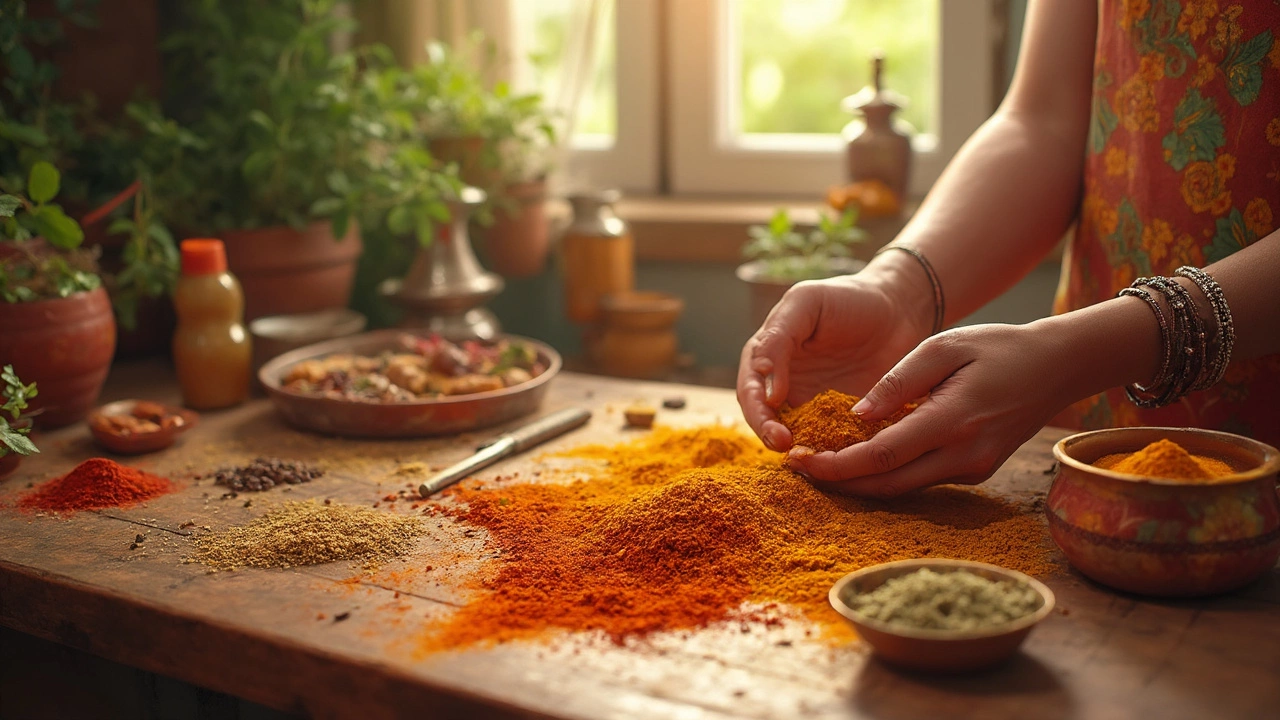So, you've set your heart on making biryani today. You're ready, pots and pans in place, rice soaking. But then, the saga unfolds: no biryani masala. Don't sweat it! Many spices in your pantry can team up to craft a decent substitute.
Biryani masala packs a punch with aromatic, bold flavors that give biryani its signature taste. Cardamom, cumin, and coriander, oh my! While store-bought blends are convenient, a homemade version can be just as magical.
The good news? You can make a biryani masala substitute with what you've probably already got on your spice rack. It won’t be spot on, but it'll get you pretty darn close. Plus, who can resist that homemade touch?
- Understanding Biryani Masala
- Common Ingredients in Biryani Masala
- DIY Biryani Masala Substitute
- Tasting Tips for Perfect Biryani
Understanding Biryani Masala
Biryani masala is like the secret handshake in a club, except the club is a delicious pot of biryani. Rich, flavorful, and aromatic, this spice blend is what makes biryani the star of the show on many dining tables.
What gives biryani its unique aura? Well, it's the perfect harmony of spices. A typical biryani masala includes cloves, cardamom, cinnamon, and nutmeg. A dash of star anise too. When these spices come together, they create a deep, complex flavor that's hard to replicate with anything else.
Aside from adding an exotic taste, biryani masala also gives the dish its classic aroma. Ever walked into a kitchen where biryani is cooking? That's not just the rice; it’s the spice symphony. Pakistan and India both boast countless regional variations of this blend, each adding its own twist.
Now, if you’re curious, here's a fun fact: the origin of biryani masala blends can be traced back centuries to the royal kitchens of the Mughal Empire. Those chefs didn't have today's grinding machines, but they sure knew a thing or two about spices!
But hey, don't be daunted by traditions. Making your own substitute mix isn’t about perfection. It’s about bringing those lively flavors closer to home, even when the store-bought biryani masala isn’t there. Consider it food bravery!
Common Ingredients in Biryani Masala
Ever wondered what's inside that magical packet of biryani masala? Brace yourself, because it's a whirlwind of spices coming together like the perfect band of flavors! Each spice plays its role in making your biryani dish stand out.
The backbone of any good homemade biryani masala includes some familiar faces:
- Cumin Seeds: This brings an earthy tone that's hard to miss.
- Coriander Seeds: Adds a citrusy pop that's fresh and uplifting.
- Cardamom Pods: Both green and black cardamoms lend sweet and smoky aromas.
- Cloves: A little goes a long way in bringing warmth to the mix.
- Cinnamon: Offers a sweet and woody fragrance that's a classic in biryani.
- Bay Leaves: Used more for their subtle fragrance and a hint of bitterness.
- Black Peppercorns: Adds the necessary heat without overwhelming.
- Nutmug and Mace: These are optional but they add complexity to the flavor profile.
- Red Chili Powder: For that kick and a tad bit of color.
Each ingredient has a story, and together they sing in harmony, making your biryani truly special. Some people like to add star anise or a hint of saffron to jazz it up even more.
Remember, not every biryani masala is the same. Different regions have their own spin, adding or subtracting spices to suit local palates. This is what makes creating your own version exciting and personal. Play around with these ingredients and find what makes your taste buds dance!

DIY Biryani Masala Substitute
Running low on biryani masala? Don't fret. You can whip up a homemade blend that’ll save the day. In fact, concocting your own gives you the control to tweak spices as you like them. Here's how you can recreate that lovely medley of flavors.
The trick is to capture the essence of the original masala mix. Typically, homemade biryani masala features a variety of spices such as cumin, coriander, cinnamon, cloves, and a splash of nutmeg for mystery.
Here’s a basic mix you can toss together that's decent and super handy:
- Cumin Powder: 2 teaspoons
- Coriander Powder: 2 teaspoons
- Garam Masala: 1 teaspoon (if you don't have it, just add a pinch more of allspice!)
- Tumeric: 1 teaspoon for color and earthiness
- Red Chili Powder: 1 teaspoon if you like a kick
- Cinnamon: A pinch or small stick, ground
- Cloves: 3-4, ground, for that aromatic zing
- Nutmeg: A teeny pinch to add depth
Mix these all up and keep them in an airtight container. This blend can work wonders to infuse regular biryani with that much-loved aromatic profile.
A little math to help you manage your spice mix better:
| Spice | Proportion (%) |
|---|---|
| Cumin | 25 |
| Coriander | 25 |
| Others | 50 |
Testing new combinations doesn't just make delicious biryani, it’s kind of a fun and enlightening kitchen experiment. Plus, you can adjust it each time to match your mood or preferences. Remember, it's all about balance and building that rich, layered flavor that makes biryani something special.
Tasting Tips for Perfect Biryani
Nailing the perfect flavor for biryani can feel like cracking a code. It's got to have that rich aroma and the right kick of spices. So, how do you know if you're hitting the mark, especially when you're using a biryani masala substitute? Here are some tips to guide you through.
First, taste as you go. Seasoning in stages can help you control the spice levels and avoid accidental over-spicing. Keep in mind that flavors intensify as they cook, so go easy at first.
Balance is everything. If your biryani tastes too spicy, try adding a bit of yogurt or cream to cool things down. On the flip side, if it feels flat, a squeeze of fresh lemon can brighten it up.
Consider the texture too. The rice should be fluffy, not mushy. Cooking the rice till it's 70% done before mixing with your masala helps prevent overcooking.
Finally, let your biryani rest. Once everything is layered and cooked, give it a few minutes before serving. Those few minutes let the flavors meld together beautifully.
The best part about using a homemade biryani masala substitute? You can tweak to suit your taste. Want a bit more punch? Add extra chili. Prefer a warm, woody aroma? Toss in a dash more of cinnamon or cloves. Your taste buds, your rules!
